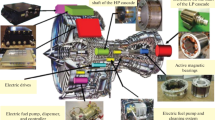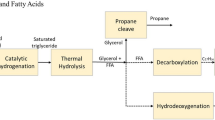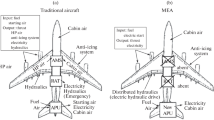Abstract
More electric engines (MEEs) and more electric aircraft are mainly implemented to address the global warming issue and make engines more fuel efficient. Developing technology has made them applicable. This paper presents a detailed introduction to the MEE for civil aircraft, including its architecture, characteristics and performance, as well as the potential benefits of fuel consumption and emissions reduction. It is obvious that the adoption of electric components, such as active magnet bearings, electric starters and generators and electric fuel pumps, is beneficial. It is especially advantageous when mechanical, hydraulic and pneumatic systems with great weight and complex structures are eliminated. Moreover, the exploration of electric propulsion systems indicates that the potential profits are large and tempting. The challenges and technology bottlenecks for MEEs are also discussed. With the further development of battery and motor technology, the MEE will undoubtedly play a dominant role in the civil aircraft market.

















Similar content being viewed by others
References
Boeing Commercial Market Outlook 2019–2038, [Online]. Available: http://www.boeing.com/commercial/market/commercial-market-outlook
Advisory Council for Aeronautics Research in Europe (2010) Aeronautics and air transport: beyond vision 2020 towards 2050 [Online]. Available: http://www.acare4europe.org/docs/towards2050.pdf
Strategic Research and Innovation Agenda Volume 1 (2012) Advisory Council for aviation research and innovation in Europe. Available: https://www.acare4europe.org/sites/acare4europe.org/files/document/ACARE-Strategic-Research-Innovation-Volume-1.pdf
Liu Y, Deng J, Liu C et al (2018) Energy optimization analysis of the more electric aircraft. IOP Conf Ser Earth Environ Sci 113:0112152. https://doi.org/10.1088/1755-1315/113/1/012152
Wheeler P (2016) Technology for the more and all electric aircraft of the future. In: 2016 IEEE international conference on automatica (ICA-ACCA), Curico, 2016, pp 1–5. https://doi.org/10.1109/ICA-ACCA.2016.7778519
Setlak L, Kowalik R (2017) Modern technological solutions in generation, transmission and distribution of electricity in “conventional” vs. “More Electric” Aircrafts. In: 2017 Progress in applied electrical engineering (PAEE), Koscielisko, 2017, pp 1–6. https://doi.org/10.1109/PAEE.2017.8009008
Alcorta-Garcia E, Zolghadri A, Goupil P (2011) A nonlinear observer-based strategy for aircraft oscillatory failure detection: A380 case study. IEEE Trans Aerosp Electron Syst 47(4):2792–2806. https://doi.org/10.1109/TAES.2011.6034665
Ghodbane A, Saad M, Hobeika C, Boland J, Thibeault C (2016) Design of a tolerant flight control system in response to multiple actuator control signal faults induced by cosmic rays. IEEE Trans Aerosp Electron Syst 52(2):681–697. https://doi.org/10.1109/TAES.2015.140787
Morioka N, Oyori H (2011) Fuel pump system configuration for the more electric engine. Aerosp Technol Conf Expos. https://doi.org/10.4271/2011-01-2563
Mo D (2021) Conceptual design of a two-shaft high bypass turbofan engine for entry-into-service 2025. MSc Thesis, Cranfield University
National Academies of Sciences, Engineering, and Medicine (2016) Commercial aircraft propulsion and energy systems research: reducing global carbon emissions. The National Academies Press, Washington, DC. https://doi.org/10.17226/23490
Bradley MK, Droney CK (2015) Subsonic ultra green aircraft research: phase II—volume II—hybrid electric design exploration, NASA/CR-2015-218704. https://doi.org/10.2060/20150017039
Eaton D, Rama J, Singhal S (2010) Magnetic bearing applications and economics. In: 2010 record of conference papers industry applications society 57th annual petroleum and chemical industry conference (PCIC), pp 1–9. https://doi.org/10.1109/PCIC.2010.5666819
Sun L (2013) A review of more electric engine technology and the preliminary application to a long range Bizet engine. Cranfield University MSc Thesis. https://mta.cranfield.ac.uk/handle/1826.1/6695
Maciej H, Krzysztof F, Aleksander O (2018) The analysis of “more electric engine” technology to improve the environmental performance of aircraft jet engine. E3S Web Conf 46:00029. https://doi.org/10.1051/e3sconf/20184600029
Yang T, Gao F, Bozhko S et al (2018) Power electronic systems for aircraft. Control Power Electron Convert Syst 2:333–368. https://doi.org/10.1016/B978-0-12-816136-4.00025-7
Zharkov MA, Sidorov VE (2019) Electric starter system for launching a gas turbine aircraft engine. In: 2019 20th international conference of young specialists on micro/nanotechnologies and electron devices (EDM), pp 700–704. https://doi.org/10.1109/EDM.2019.8823513
Shoujun S, Weiguo L, Peitsch D et al (2010) Detailed design of a high speed switched reluctance starter/generator for more/all electric aircraft. Chin J Aeronaut 23(2):216–226. https://doi.org/10.1016/S1000-9361(09)60208-9
Mitcham AJ, Cullen JJA (2002) Permanent magnet generator options for the more electric aircraft. In: 2002 international conference on power electronics, machines and drives, pp 241–245. https://doi.org/10.1049/cp:20020121
Moir I, Seabridge AG (2006) Vehicle management systems in military avionics systems. Wiley, New York, pp 399–401
Wheeler P, Bozhko S (2014) The more electric aircraft: technology and challenges. IEEE Electrif Mag 2(4):6–12
Madonna V, Giangrande P, Galea M (2018) Electrical power generation in aircraft: review, challenges, and opportunities. IEEE Trans Transp Electrif 4(3):646–659
Bhangu BS, Rajashekara K (2011) Control strategy for electric starter generators embedded in gas turbine engine for aerospace applications. In: 2011 IEEE energy conversion congress and exposition, Phoenix, AZ, pp 1461–1467. https://doi.org/10.1109/ECCE.2011.6063953
Chakraborty I, Trawick D, Jackson D et al (2013) Electric control surface actuator design optimization and allocation for the more electric aircraft. AIAA Aviat. https://doi.org/10.2514/6.2013-4283
Kang JG, Kwon JY, Lee MS (2021) A Dynamic power consumption estimation method of electro-mechanical actuator for UAV modeling and simulation. Int J Aeronaut Space Sci. https://doi.org/10.1007/s42405-021-00417-4
Charles EL, Larry WH, Jonathon R et al (2016) Parallel hybrid gas-electric geared turbofan engine conceptual design and benefits analysis. AIAA 2016–4610:1–13. https://doi.org/10.2514/6.2016-4610
Novák A (2022) Design of batteries for a hybrid propulsion system of a training aircraft. Energies 15:49. https://doi.org/10.3390/en15010049
Friedrich C, Robertson PA (2015) Hybrid-electric propulsion for automotive and aviation applications. CEAS Aeronaut J 6(2):279–290
Aymat A (2018) Appropriate aircraft configuration for hybrid electric propulsion. Cranfield University MSc Thesis. https://mta.cranfield.ac.uk/handle/1826.1/13634
Byun H, Park S (2018) Thrust control loop design for electric-powered UAV. JASS 19:100–110. https://doi.org/10.1007/s42405-018-0003-9
Yang J (2018) Development of performance model for the prediction of trip energy for a generic electric hybrid engine on transport aircraft. Cranfield University MSc Thesis. https://mta.cranfield.ac.uk/handle/1826.1/13598
Robert C, Gerald M, Mark J et al (2003) Design and fabrication of high-temperature, radial magnetic bearing for turbomachinery. NASA/TM-2003-212300, ARL-TR-2954
Zharkov MA, Sidorov VE (2019) Electric starter system for launching a gas turbine aircraft engine. In: 20th international conference of young specialists on micro/nanotechnologies and electron devices (EDM), pp 700–704. https://doi.org/10.1109/EDM.2019.8823513
Sun J, Kuang Z, Wu H, Wang S, Ning G (2011) Implementation of a high-speed switched reluctance.starter/generator system. In: International conference on electrical machines and systems, pp 1–5. https://doi.org/10.1109/ICEMS.2011.6073921
Spierling T, Lents C (2019) Parallel hybrid propulsion system for a regional turboprop: conceptual design and benefits analysis. AIAA 2019–4466:1–13. https://doi.org/10.2514/6.2019-4466
Pornet C, Gologan C, Vratny PC et al (2015) Methodology for sizing and performance assessment of hybrid energy aircraft. J Aircr 52(1):341–352. https://doi.org/10.2514/1.C032716
Aigner B, Nollmann M, Stumpf E (2018) Design of a hybrid electric propulsion system within a preliminary aircraft design software environment. Deutscher Luftund Raumfahrtkongress, Deutsche Gesellschaft für Luft- und Raumfahrt -Lilienthal-Oberth e.V., Bonn, 2018, pp 1–14
Liu Y (2021) Optimization of hybrid electric propulsion system. MSc Thesis, Cranfield University
Samuelsson S, Grnstedt T (2021) Performance analysis of turbo-electric propulsion system with fuselage boundary layer ingestion. Aerosp Sci Technol 109:106412
Voskuijl M, van Bogaert J et al (2018) Analysis and design of hybrid electric regional turboprop aircraft. Ceas Aeronaut J 9:15–25
Karadotcheva E, Nguyen SN, Greenhalgh ES, Shaffer MSP, Kucernak ARJ, Linde P (2021) Structural power performance targets for future electric aircraft. Energies 14:6006. https://doi.org/10.3390/en14196006
Hospodka J, Bínová H, Pleninger S (2020) Assessment of all-electric general aviation aircraft. Energies 13(23):6206. https://doi.org/10.3390/en13236206
Finger DF, Braun C, Bil C Case studies in initial sizing for hybrid-electric general aviation aircraft. AIAA 2018-5005. https://doi.org/10.2514/6.2018-5005
Donateo T, Ficarella A (2017) Designing a hybrid electric powertrain for an unmanned aircraft with a commercial optimization software. SAE Int J Aerosp 10(1):1–11. https://doi.org/10.4271/2017-01-9000
Berton JJ, Haller WJ (2014) A noise and emissions assessment of the N3-X transport. In: 52nd aerospace sciences meeting, National Harbor, MD. https://doi.org/10.2514/6.2014-0594
Acknowledgements
The authors would like to thank the AECC Shenyang Engine Research Institute for funding and support.
Author information
Authors and Affiliations
Corresponding author
Ethics declarations
Conflict of interest
The authors declare that they have no known competing financial interests or personal relationships that could have appeared to influence the work reported in this paper.
Additional information
Publisher's Note
Springer Nature remains neutral with regard to jurisdictional claims in published maps and institutional affiliations.
An earlier version of this paper was presented at APISAT 2021, Jeju, South Korea, in November 2021.
Rights and permissions
About this article
Cite this article
Liu, Y., Mo, D., Nalianda, D. et al. Review of More Electric Engines for Civil Aircraft. Int. J. Aeronaut. Space Sci. 23, 784–793 (2022). https://doi.org/10.1007/s42405-022-00469-0
Received:
Revised:
Accepted:
Published:
Issue Date:
DOI: https://doi.org/10.1007/s42405-022-00469-0




